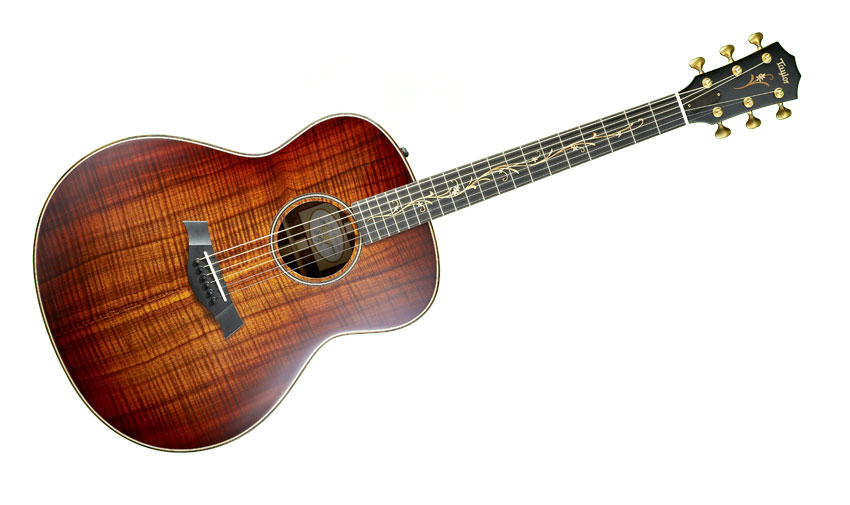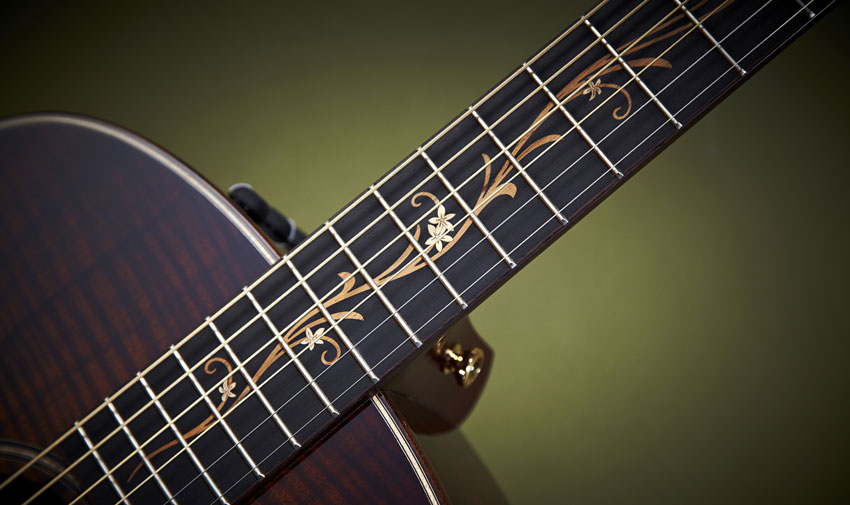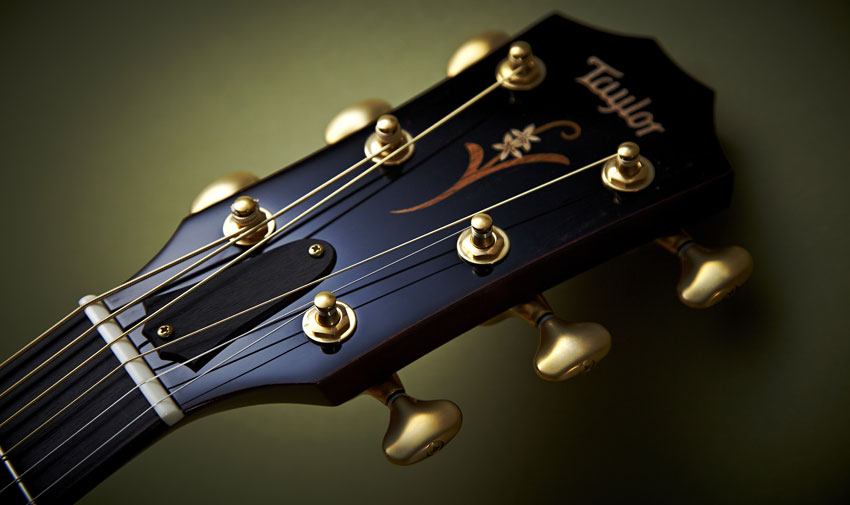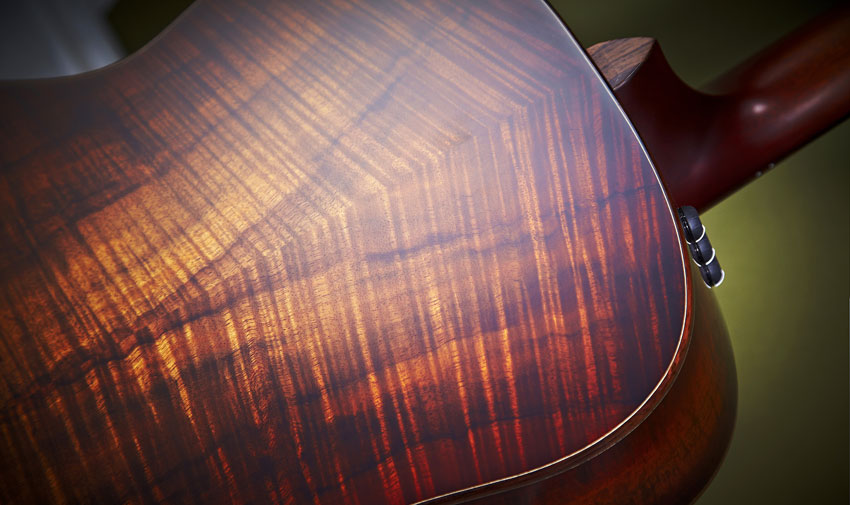MusicRadar Verdict
Slightly 'older' sounding to our ears than the 518e, this is one of those dream guitars that ticks all the boxes.
Pros
- +
Very understated 'posh' vibe. Concept. Build. 'Small body' response. Tonal balance.
Cons
- -
A beautiful guitar, if you have the money.
MusicRadar's got your back

Taylor Grand Orchestra K28e review

Neck joint

Headstock

Back
We take a look at the high-end Koa-bodied K28e, one of several new guitars to feature Taylor's overhauled Grand Orchestra shape.
The new Taylor Grand Orchestra (GO) is an imposing piece. At 425.5mm (16.75 inches) across its lower bout and 524mm (20.625 inches) long, it's bigger than Taylor's Grand Symphony (GS) (412.75mm/16.25 inches wide and 508mm/20 inches long) - and it's deeper, too (123mm/ 4.84 inches compared with 117.5mm/4.625 inches).
Technically, the guitar it replaces, the Taylor jumbo (JM), was bigger still - 432mm (17 inches) wide and 533mm (21 inches) long, but with the same GS depth of 117.5mm. The GO appears more Taylor- like in style, too, in comparison with the previous JM: its upper and lower bouts are slightly trimmer with a less waspish waist. It appears like a slighter larger version of the Bob Taylor designed GS, introduced in 2006. The new GO, however, was conceived by Taylor's new master builder, Andy Powers.
Build
Along with Taylor's numbered 100 to 900 series, there are two other mini ranges available: the Presentation and the Koa. The K28e falls into the latter. The model's first digit, in this case a '2', means that the top is the same wood as the back and sides: Hawaiian koa.
"The top has a fine 'fiddleback' flame that sits at perfect right angles to the longitudinal grain stripes"
It's certainly a looker. The top has a fine 'fiddleback' flame that sits at perfect right angles to the longitudinal grain stripes. It has a shaded edge burst that subtly darkens the outer edges, which are picked out with a maple purfling inside the rosewood edge binding. Like the top, the back is centre- jointed and bookmatched with a strong curve to the figure; the sides are again heavily figured. We get to see plenty of spectacular pieces of wood, but this selection is up there with the very, very best.
Even the 'island vine' fingerboard inlay on the unusual rosewood-bound ebony fingerboard doesn't offend like some vine-style inlays do. It uses inlaid blackwood and maple, and the muted browns really suit the chocolate lustre of the koa; it's the same deal with the head logo and rosette. Classy.
A set of antique gold 510 Gotoh tuners - probably the best-looking modern tuner there is - look fabulous, and smooth is the word for their action. As with the Presentation and 900 series, a bone nut (with no sharp edges like the Tusq nut of the 518e) and a compensated bone saddle are standard.
The 'e' suffix denotes that the guitar features Taylor's Expression System (ES). Its discreet forward shoulder-placed and centre-notched bass, treble and volume controls give a surprisingly wide array of colours. Hidden from view are the two sensors - one is placed to the bass side of the bridge, and you'll find the other buried within the neck joint. Mounted on the preamp's circuit board is a small slide switch that allows you to turn the body sensor on or off.
Sounds
"When it comes to koa, people talk of a high-end-y sound that needs some time to mellow and open. Well, that's not what we are hearing"
When it comes to koa, people talk of a high-end-y sound that needs some time to mellow and open. Well, that's not what we are hearing. The K28e has balance and powerful projection, but there's a little more fundamental in the lows, and what we might call an old sound - perhaps, a little less hi-fi than spruce-topped acoustics. Strummed, it sounds even and quite 'clicky', and would certainly make for a great rhythm bed, even though that low-end is really moving into bass guitar territory.
You wouldn't imagine a big guitar to be that fingerstyle friendly, but this guitar excels, especially if you use a lot of basslines in your style. Played with the flesh, rather than nail of your thumb, the low E and A sound really bass guitar-like, and, by design, you don't have to dig in too much to get your sound out. There's a much more 'small body' response in that regard, and the dynamic range is very impressive.
Pulling out a couple of dreadnoughts (a Martin and an old Tacoma) to compare, it's rare that a dread sounds deficient in the low-end, but they really do. The Martin, especially, provides that typical upper-mid thrust, but the GO just seems more tonally balanced. We can't stress this enough. Listening to a smaller-cutaway PRS Angelus, it matched the GO for low-end, but to our ears the lows sound a little over-egged.
A recording test - using the ES output - definitely narrows the game a little, especially with other instruments at play in the track, and through a variety of amps the relative smoothness of the ES really suits this guitar. Likewise, the two-band EQ can tighten the low-end - which certainly might be necessary live - or tame or enhance the highs, depending on your taste.
This Grand Orchestra leaves us with a quandary: who, exactly, is it designed for? As a big, bold strummer, it's an easy fit for the soloist, less so for ensemble use (especially if you have a bassist), because it really does take up so much sonic space.
For the fingerstyle player or the hybrid picker, this model is surprisingly rewarding, especially if you have the ability to voice bassline, chords and melody and/or use dropped tunings. It might be an unusual statement, but we could hear these in the hands of a jazzer, or even a bossa nova stylist who's more accustomed to nylon strings.
Conversely, the GO excels as a huge-sounding 'rock' acoustic: big open-string chords just sound fantastic, and there's a good tonal body for lead lines and solos. Can you see our dilemma?
But our overriding thought is about the tonal balance. Plenty of big guitars give you low-end, but fewer are quite as well balanced as the GO. It has a superb balance, and for such a big guitar it's surprisingly dynamic, powerful and responsive. You really don't have to dig in hard to get the sound out. Put another way, if big guitars aren't your thing, it's time to change your opinion. It's not quite an orchestra, but it's damn close.
Dave Burrluck is one of the world’s most experienced guitar journalists, who started writing back in the '80s for International Musician and Recording World, co-founded The Guitar Magazine and has been the Gear Reviews Editor of Guitarist magazine for the past two decades. Along the way, Dave has been the sole author of The PRS Guitar Book and The Player's Guide to Guitar Maintenance as well as contributing to numerous other books on the electric guitar. Dave is an active gigging and recording musician and still finds time to make, repair and mod guitars, not least for Guitarist’s The Mod Squad.
AC/DC - ranked! All 17 studio albums, from worst to best
“He seems to access a different part of his vast library of music genre from the jukebox-in-his-head! This album is a round-the-world musical trip”: Joe Bonamassa announces new album, Breakthrough – listen to the title-track now
"The Rehearsal is compact, does its one job well, and is easy to navigate without needing instructions": Walrus Audio Canvas Rehearsal review










